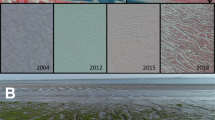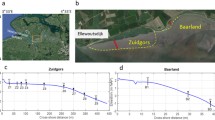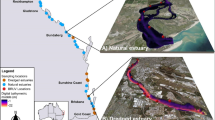Abstract
When conducting ecological research on tidal mudflats, understanding how long any given area is underwater is vitally important. This paper describes a method for calculating the percent inundation time for a single tidal cycle (neap to spring tide) within a GIS environment. The primary variable is elevation, thus, having an accurate digital elevation model (DEM) is critical. Output from the model can then be integrated into existing biological databases to help interpret and understand the ecology of tidal mudflats.







Similar content being viewed by others
References
Carew R, Hickey R (2000) Determination of a generalized tidal inundation model for Roebuck Bay (Western Australia) using an integrated GIS and remote sensing approach. Trans GIS 4(2):99–111
Connell JH (1961a) Effects of competition, predation by Thais lapillus, and other factors on natural populations of the barnacle Balanus balanoides. Ecol Monogr 31:61–104
Connell JH (1961b) The influence of interspecific competition and other factors on the distribution of the barnacle Chthamalus stellatus. Ecology 42:710–723
de Goeij, P., M. Lavaleye, G. Pearson, and T. Piersma. 2003. Seasonal changes in the macro-zoobenthos of a tropical mudflat. Netherlands Institute for sea Research (NIOZ). NIOZ-Report 2003-4. 49p
Denny M, Paine R (1998) Celestial mechanics, sea-level changes, and intertidal ecology. Biol Bull 194:108–115
Department of the Navy. Hydrographic Branch. 1994. Australian National Tide Tables: Australia, Papua & New Guinea, Australian Hydrographic Publication 11
Doty MS (1946) Critical tide factors that are correlated with the vertical distribution of marine algae and other organisms along the Pacific coast. Ecology 27:315–328
Druehl LD, Green JM (1982) Vertical-distribtuion of inter-tidal seaweeds as related to patterns of submersion and emersion. Marine Ecology-Progress Series 9:163–170
Fraschetti S, Terlizzi A, Benedetti-Cecchi L (2005) Patterns of distribution of marine assemblages from rocky shores: evidence of relevant scales of variation. Marine Ecology-Progress Series 296:13–29
Honkoop P, Pearson G, Lavaleye M, Piersma T (2006) Spatial variation of the intertidal sediments and macrozoo-benthic assemblages along Eighty-Mile Beach, North-Western Australia. J Sea Res 55:278–291
Murray N, Phinn S, DeWitt M, Ferrari R, Johnston R, Lyons M, Clinton N, Thau D, Fuller R (2019) The global distribution and trajectory of tidal flats. Nature. 565:222–225
Pepping, M., T. Piersma, G. Pearson, and M. Lavaleye (eds.). 1999. Intertidal sediments and benthic animals of Roebuck Bay, Western Australia. Texel, Netherlands: Netherlands Institute for Sea Research (NIOZ) 214p
Piersma T., G. Pearson, R. Hickey, and M. Lavaleye (eds.). 2005. The long mud: Benthos and shorebirds of the foreshore of Eighty-Mile Beach, Western Australia. Texel, Netherlands: Netherlands Institute for sea Research (NIOZ). NIOZ Report 2005-2. 218p
Piersma T., G. Pearson, R. Hickey, S. Dittmann, D. Rogers, E. Folmer, P. Honkoop, J. Drent, and P. de Goeij. 2006. Roebuck Bay invertebrate and bird mapping 2006. https://teampiersma.org/home/east-asian-australasian-flyway/benthic-invertebrate-mapping/. Accessed 10 April 2019
Piersma, T., G. Pearson, M. Lavaleye, R. Hickey, D. Rogers, S. Holthuijsen, S. Marin-Estrella, P. de Goeij, N. Findlay, and A. Storey. 2016, Anna Plains and Roebuck Bay benthic invertebrate mapping 2016: AnnRoeBIM16. Field Report. 96p. https://teampiersma.org/home/east-asian-australasian-flyway/benthic-invertebrate-mapping/. Accessed 10 April 2019
Rogers D, Piersma T, Lavaleye M, Pearson G, de Goeij P (2003) Life Along Land’s Edge. Department of Conservation and Land Management, Kensington, NSW, Australia, p 162
van de Kam J, Ens B, Piersma T, Zwarts L (2004) Shorebirds. An illustrated behavioural ecology. KNNV Publishers, Utrecht 368p
Acknowledgements
The author would like to thank all those who have made the Roebuck Bay and Eighty Mile Beach research possible – specifically the senior scientists (Grant Pearson, Theunis Piersma, Marc Lavaleye, Petra De Goeij, and Danny Rogers) and the varied funding organizations that made fieldwork possible. I also acknowledge the work done by various editors and reviewers of this document.
Author information
Authors and Affiliations
Corresponding author
Additional information
Publisher’s note
Springer Nature remains neutral with regard to jurisdictional claims in published maps and institutional affiliations.
Rights and permissions
About this article
Cite this article
Hickey, R. Tidal inundation modeling within GIS. J Coast Conserv 23, 599–606 (2019). https://doi.org/10.1007/s11852-019-00690-2
Received:
Revised:
Accepted:
Published:
Issue Date:
DOI: https://doi.org/10.1007/s11852-019-00690-2




